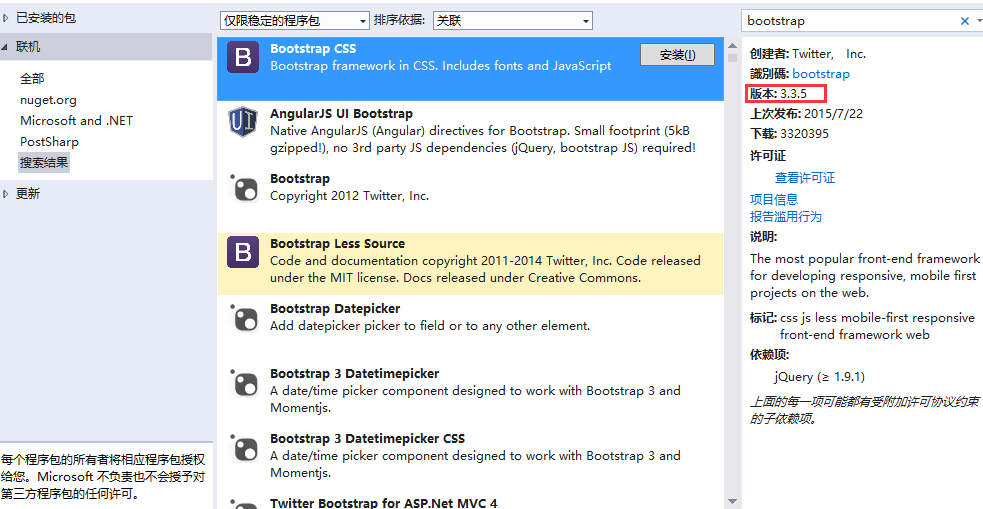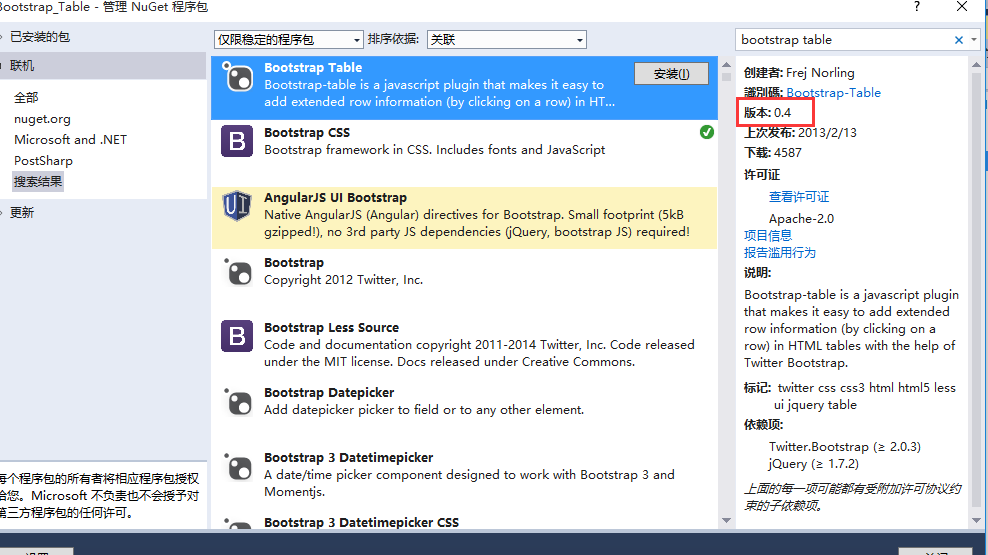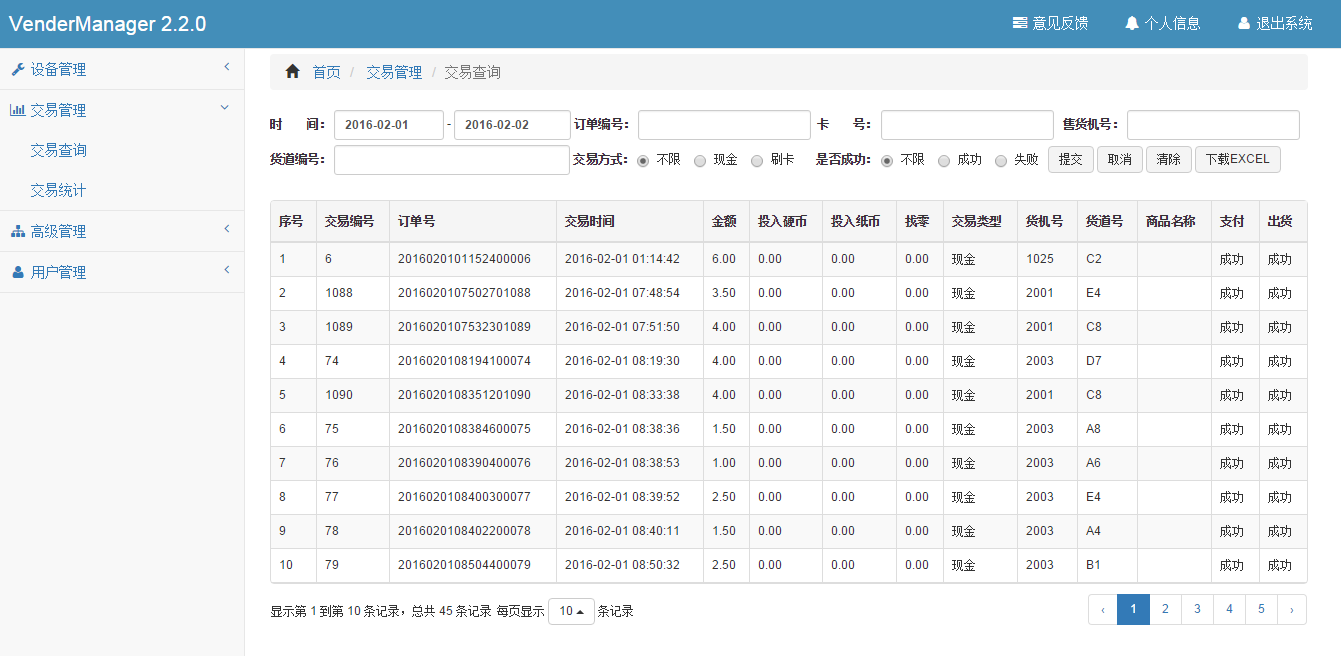 interface Web
interface Web
 js tutoriel
js tutoriel
 Explication détaillée de la table d'amorçage des artefacts des composants de la table JS (version améliorée)
Explication détaillée de la table d'amorçage des artefacts des composants de la table JS (version améliorée)
Explication détaillée de la table d'amorçage des artefacts des composants de la table JS (version améliorée)
1. Introduction de Bootstrap Table
Concernant l'introduction de Bootstrap Table, il existe généralement deux méthodes :
1. Téléchargez directement le code source et ajoutez-le au projet. .
Puisque Bootstrap Table est un composant de Bootstrap, cela dépend de Bootstrap. Nous devons d'abord ajouter une référence à Bootstrap.
2. Utilisez notre Nuget magique
pour ouvrir Nuget et rechercher ces deux packages

Bootstrap est déjà la dernière version 3.3.5, nous venons de le faire. installez-le directement.

La version de Bootstrap Table est en réalité la 0.4, ce qui est trop trompeur. Par conséquent, le blogueur suggère que le package Bootstrap Table soit téléchargé directement à partir du code source. La dernière version de Bootstrap Table semble être la 1.9.0.
Introduction au contexte de cet article :
Récemment, les clients ont soulevé des demandes et souhaitent optimiser le système de gestion d'origine afin qu'il puisse être bien affiché sur les téléphones mobiles. :
Un plan : conserver la page d'origine et concevoir un nouvel ensemble de pages adaptées aux téléphones mobiles. Lorsque vous y accédez par téléphone mobile, entrez m.zhy.com (page mobile), lorsque vous y accédez par un appareil PC, entrez. www.zhy.com (page PC) )
Plan b : Utilisez le framework bootstrap pour remplacer la page d'origine et s'adapter automatiquement aux téléphones mobiles, tablettes et appareils PC
Si vous utilisez. plan a, vous devez concevoir une interface et réécrire la page appropriée, en tenant compte des problèmes de temps et de coûts, le projet a adopté le plan b
2. Affichage des effets

2. Brève introduction à la table BootStrap
la table bootStrap est un plug-in de table léger qui utilise AJAX pour obtenir des données au format JSON. Sa pagination et son remplissage de données sont très pratiques et prennent en charge l'internationalisation
<.>
<!--css样式--> <link href="css/bootstrap/bootstrap.min.css" rel="stylesheet"> <link href="css/bootstrap/bootstrap-table.css" rel="stylesheet"> <!--js--> <script src="js/bootstrap/jquery-1.12.0.min.js" type="text/javascript"></script> <script src="js/bootstrap/bootstrap.min.js"></script> <script src="js/bootstrap/bootstrap-table.js"></script> <script src="js/bootstrap/bootstrap-table-zh-CN.js"></script>
<table data-toggle="table"> <thead> ... </thead> </table> ...
$('#table').bootstrapTable({
url: 'data.json'
});$(function () {
//1.初始化Table
var oTable = new TableInit();
oTable.Init();
//2.初始化Button的点击事件
/* var oButtonInit = new ButtonInit();
oButtonInit.Init(); */
});
var TableInit = function () {
var oTableInit = new Object();
//初始化Table
oTableInit.Init = function () {
$('#tradeList').bootstrapTable({
url: '/VenderManager/TradeList', //请求后台的URL(*)
method: 'post', //请求方式(*)
toolbar: '#toolbar', //工具按钮用哪个容器
striped: true, //是否显示行间隔色
cache: false, //是否使用缓存,默认为true,所以一般情况下需要设置一下这个属性(*)
pagination: true, //是否显示分页(*)
sortable: false, //是否启用排序
sortOrder: "asc", //排序方式
queryParams: oTableInit.queryParams,//传递参数(*)
sidePagination: "server", //分页方式:client客户端分页,server服务端分页(*)
pageNumber:1, //初始化加载第一页,默认第一页
pageSize: 50, //每页的记录行数(*)
pageList: [10, 25, 50, 100], //可供选择的每页的行数(*)
strictSearch: true,
clickToSelect: true, //是否启用点击选中行
height: 460, //行高,如果没有设置height属性,表格自动根据记录条数觉得表格高度
uniqueId: "id", //每一行的唯一标识,一般为主键列
cardView: false, //是否显示详细视图
detailView: false, //是否显示父子表
columns: [{
field: 'id',
title: '序号'
}, {
field: 'liushuiid',
title: '交易编号'
}, {
field: 'orderid',
title: '订单号'
}, {
field: 'receivetime',
title: '交易时间'
}, {
field: 'price',
title: '金额'
}, {
field: 'coin_credit',
title: '投入硬币'
}, {
field: 'bill_credit',
title: '投入纸币'
}, {
field: 'changes',
title: '找零'
}, {
field: 'tradetype',
title: '交易类型'
},{
field: 'goodmachineid',
title: '货机号'
},{
field: 'inneridname',
title: '货道号'
},{
field: 'goodsName',
title: '商品名称'
}, {
field: 'changestatus',
title: '支付'
},{
field: 'sendstatus',
title: '出货'
},]
});
};
//得到查询的参数
oTableInit.queryParams = function (params) {
var temp = { //这里的键的名字和控制器的变量名必须一直,这边改动,控制器也需要改成一样的
limit: params.limit, //页面大小
offset: params.offset, //页码
sdate: $("#stratTime").val(),
edate: $("#endTime").val(),
sellerid: $("#sellerid").val(),
orderid: $("#orderid").val(),
CardNumber: $("#CardNumber").val(),
maxrows: params.limit,
pageindex:params.pageNumber,
portid: $("#portid").val(),
CardNumber: $("#CardNumber").val(),
tradetype:$('input:radio[name="tradetype"]:checked').val(),
success:$('input:radio[name="success"]:checked').val(),
};
return temp;
};
return oTableInit;
};BufferedReader bufr = new BufferedReader(
new InputStreamReader(request.getInputStream(),"UTF-8"));
StringBuilder sBuilder = new StringBuilder("");
String temp = "";
while((temp = bufr.readLine()) != null){
sBuilder.append(temp);
}
bufr.close();
String json = sBuilder.toString();
JSONObject json1 = JSONObject.fromObject(json);
String sdate= json1.getString("sdate");//通过此方法获取前端数据
...<🎜. >
4. Paging (le plus problématique)public JsonResult GetDepartment(int limit, int offset, string orderId, string SellerId,PortId,CardNumber,Success,maxrows,tradetype)
{
...
}Lors de l'utilisation de la pagination, les données renvoyées par le serveur doivent inclure des lignes et un total. Le code est le suivant :
5. Introduction au contenu de l'interface de pagination...<br>gblst = SqlADO.getTradeList(sql,pageindex,maxrows);
JSONArray jsonData=new JSONArray();
JSONObject jo=null;
for (int i=0,len=gblst.size();i<len;i++)
{
TradeBean tb = gblst.get(i);
if(tb==null)
{
continue;
}
jo=new JSONObject();
jo.put("id", i+1);
jo.put("liushuiid", tb.getLiushuiid());
jo.put("price", String.format("%1.2f",tb.getPrice()/100.0));
jo.put("mobilephone", tb.getMobilephone());
jo.put("receivetime", ToolBox.getYMDHMS(tb.getReceivetime()));
jo.put("tradetype", clsConst.TRADE_TYPE_DES[tb.getTradetype()]);
jo.put("changestatus", (tb.getChangestatus()!=0)?"成功":"失败");
jo.put("sendstatus", (tb.getSendstatus()!=0)?"成功":"失败");
jo.put("bill_credit", String.format("%1.2f",tb.getBill_credit()/100.0));
jo.put("changes",String.format("%1.2f",tb.getChanges()/100.0));
jo.put("goodroadid", tb.getGoodroadid());
jo.put("SmsContent", tb.getSmsContent());
jo.put("orderid", tb.getOrderid());
jo.put("goodsName", tb.getGoodsName());
jo.put("inneridname", tb.getInneridname());
jo.put("xmlstr", tb.getXmlstr());
jsonData.add(jo);
}
int TotalCount=SqlADO.getTradeRowsCount(sql);
JSONObject jsonObject=new JSONObject();
jsonObject.put("rows", jsonData);//JSONArray
jsonObject.put("total",TotalCount);//总记录数
out.print(jsonObject.toString()); <br>...Le front-end récupère les données de pagination, le code est le suivant :
...<br>oTableInit.queryParams = function (params) {
var temp = { //这里的键的名字和控制器的变量名必须一直,这边改动,控制器也需要改成一样的
limit: params.limit, //第几条记录
offset: params.offset, //显示一页多少记录
sdate: $("#stratTime").val(),
};
return temp;
};<br>...Le back-end récupère les données de pagination, le code est le suivant :
Ce qui précède est l'intégralité du contenu de cet article. J'espère que cela pourra aider tout le monde à mieux apprendre la table d'amorçage des artefacts des composants de table JS....<br>int pageindex=0;
int offset = ToolBox.filterInt(json1.getString("offset"));
int limit = ToolBox.filterInt(json1.getString("limit"));
if(offset !=0){
pageindex = offset/limit;
}
pageindex+= 1;//第几页<br>...Pour des explications plus détaillées sur la table d'amorçage des artefacts des composants de table JS (version améliorée), veuillez faire attention au site Web PHP chinois !

Outils d'IA chauds

Undresser.AI Undress
Application basée sur l'IA pour créer des photos de nu réalistes

AI Clothes Remover
Outil d'IA en ligne pour supprimer les vêtements des photos.

Undress AI Tool
Images de déshabillage gratuites

Clothoff.io
Dissolvant de vêtements AI

AI Hentai Generator
Générez AI Hentai gratuitement.

Article chaud

Outils chauds

Bloc-notes++7.3.1
Éditeur de code facile à utiliser et gratuit

SublimeText3 version chinoise
Version chinoise, très simple à utiliser

Envoyer Studio 13.0.1
Puissant environnement de développement intégré PHP

Dreamweaver CS6
Outils de développement Web visuel

SublimeText3 version Mac
Logiciel d'édition de code au niveau de Dieu (SublimeText3)

Sujets chauds
 Remplacer les caractères de chaîne en javascript
Mar 11, 2025 am 12:07 AM
Remplacer les caractères de chaîne en javascript
Mar 11, 2025 am 12:07 AM
Explication détaillée de la méthode de remplacement de la chaîne JavaScript et de la FAQ Cet article explorera deux façons de remplacer les caractères de chaîne dans JavaScript: le code JavaScript interne et le HTML interne pour les pages Web. Remplacer la chaîne dans le code JavaScript Le moyen le plus direct consiste à utiliser la méthode Remplace (): str = str.replace ("trouver", "remplacer"); Cette méthode remplace uniquement la première correspondance. Pour remplacer toutes les correspondances, utilisez une expression régulière et ajoutez le drapeau global G: str = str.replace (/ fi
 Tutoriel de configuration de l'API de recherche Google personnalisé
Mar 04, 2025 am 01:06 AM
Tutoriel de configuration de l'API de recherche Google personnalisé
Mar 04, 2025 am 01:06 AM
Ce tutoriel vous montre comment intégrer une API de recherche Google personnalisée dans votre blog ou site Web, offrant une expérience de recherche plus raffinée que les fonctions de recherche de thème WordPress standard. C'est étonnamment facile! Vous pourrez restreindre les recherches à Y
 Créez vos propres applications Web Ajax
Mar 09, 2025 am 12:11 AM
Créez vos propres applications Web Ajax
Mar 09, 2025 am 12:11 AM
Vous voici donc, prêt à tout savoir sur cette chose appelée Ajax. Mais qu'est-ce que c'est exactement? Le terme Ajax fait référence à un regroupement lâche de technologies utilisées pour créer un contenu Web interactif dynamique. Le terme Ajax, inventé à l'origine par Jesse J
 Exemple Couleurs Fichier JSON
Mar 03, 2025 am 12:35 AM
Exemple Couleurs Fichier JSON
Mar 03, 2025 am 12:35 AM
Cette série d'articles a été réécrite à la mi-2017 avec des informations à jour et de nouveaux exemples. Dans cet exemple JSON, nous examinerons comment nous pouvons stocker des valeurs simples dans un fichier à l'aide du format JSON. En utilisant la notation de paire de valeurs clés, nous pouvons stocker n'importe quel type
 10 Highlighters de syntaxe jQuery
Mar 02, 2025 am 12:32 AM
10 Highlighters de syntaxe jQuery
Mar 02, 2025 am 12:32 AM
Améliorez votre présentation de code: 10 surligneurs de syntaxe pour les développeurs Partager des extraits de code sur votre site Web ou votre blog est une pratique courante pour les développeurs. Le choix du bon surligneur de syntaxe peut améliorer considérablement la lisibilité et l'attrait visuel. T
 8 Superbes plugins de mise en page JQuery Page
Mar 06, 2025 am 12:48 AM
8 Superbes plugins de mise en page JQuery Page
Mar 06, 2025 am 12:48 AM
Tirez parti de jQuery pour les dispositions de page Web sans effort: 8 plugins essentiels JQuery simplifie considérablement la mise en page de la page Web. Cet article met en évidence huit puissants plugins jQuery qui rationalisent le processus, particulièrement utile pour la création de sites Web manuels
 10 tutoriels JavaScript & jQuery MVC
Mar 02, 2025 am 01:16 AM
10 tutoriels JavaScript & jQuery MVC
Mar 02, 2025 am 01:16 AM
Cet article présente une sélection organisée de plus de 10 didacticiels sur les cadres JavaScript et JQuery Model-View-Controller (MVC), parfait pour augmenter vos compétences en développement Web au cours de la nouvelle année. Ces tutoriels couvrent une gamme de sujets, de Foundatio
 Qu'est-ce que & # x27; ceci & # x27; en javascript?
Mar 04, 2025 am 01:15 AM
Qu'est-ce que & # x27; ceci & # x27; en javascript?
Mar 04, 2025 am 01:15 AM
Points de base Ceci dans JavaScript fait généralement référence à un objet qui "possède" la méthode, mais cela dépend de la façon dont la fonction est appelée. Lorsqu'il n'y a pas d'objet actuel, cela fait référence à l'objet global. Dans un navigateur Web, il est représenté par Window. Lorsque vous appelez une fonction, cela maintient l'objet global; mais lors de l'appel d'un constructeur d'objets ou de l'une de ses méthodes, cela fait référence à une instance de l'objet. Vous pouvez modifier le contexte de ceci en utilisant des méthodes telles que Call (), Appliquer () et Bind (). Ces méthodes appellent la fonction en utilisant la valeur et les paramètres donnés. JavaScript est un excellent langage de programmation. Il y a quelques années, cette phrase était





